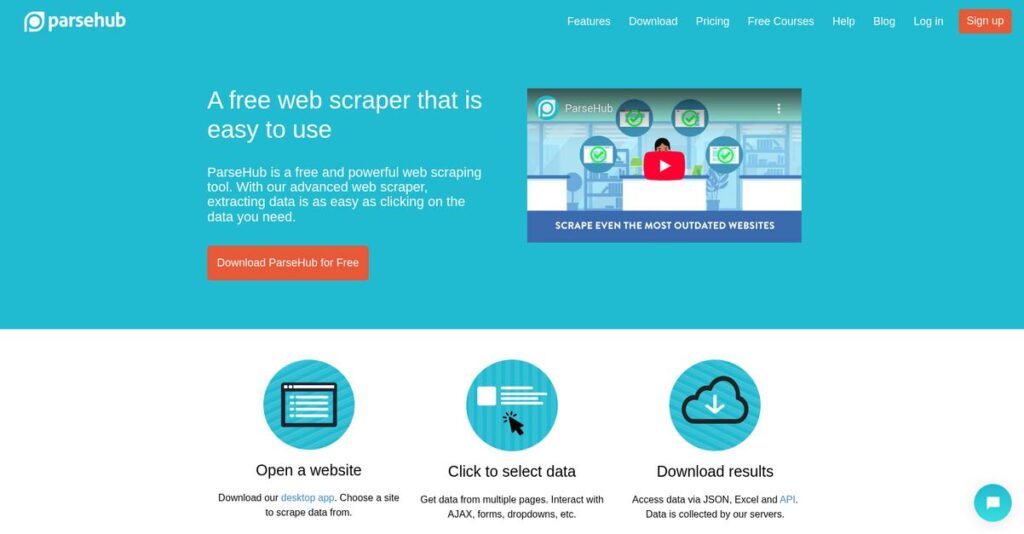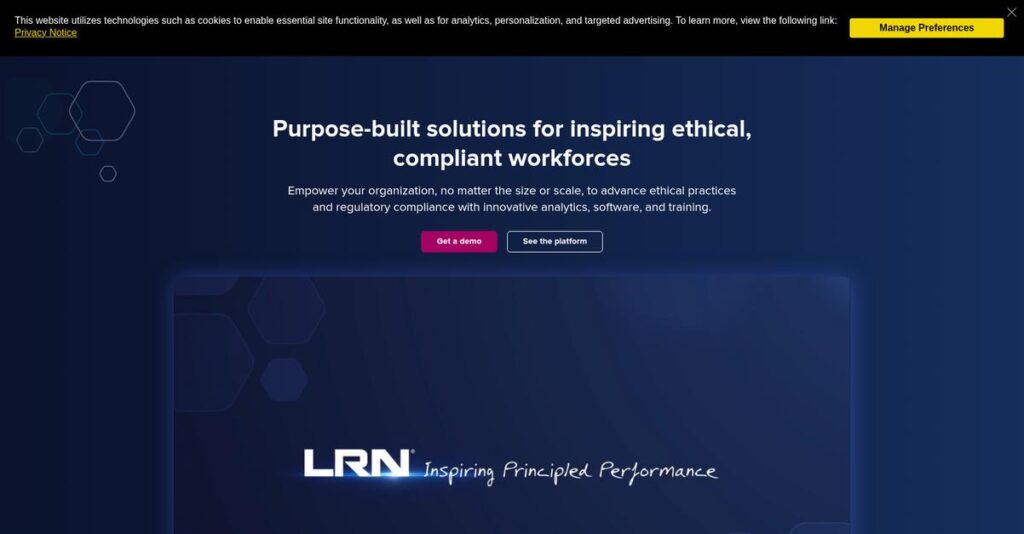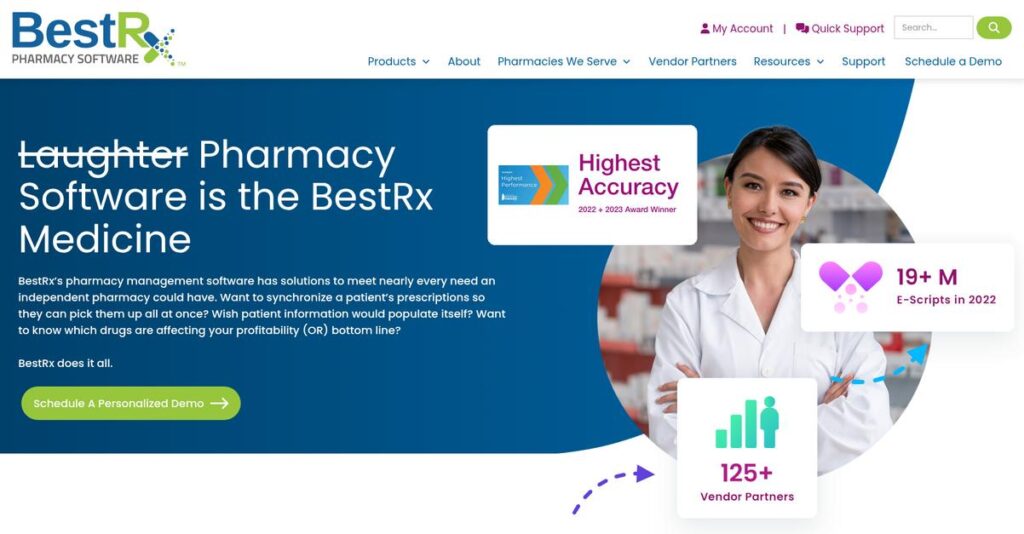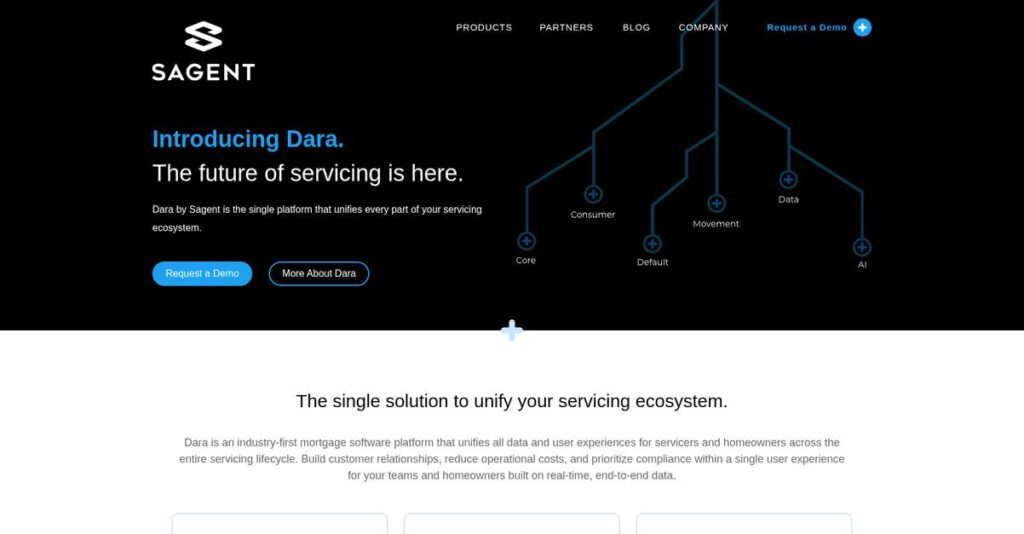Web scraping shouldn’t feel this frustrating, right?
If you’re hunting for cleaner, reliable website data but keep hitting paywalls, complex interfaces, or technical walls, you’re definitely not alone.
Every day, so much of your analysis gets delayed because extracting complete, up-to-date data from dynamic sites is just so painful.
ParseHub steps in to fix this with a truly visual, point-and-click interface that grabs data even from tricky, JavaScript-heavy websites—no coding required. Its automated scheduling, cloud storage and powerful integrations really do set it apart when I put it through its paces.
In this review, I’ll break down how ParseHub makes data collection simple for your daily projects and why that matters.
You’ll find out exactly how ParseHub performs: its visual workflow, automation tools, pricing, and where it fits compared to alternatives—so you can make an informed call.
Stick with me for the features you need to confidently pick your next web data tool.
Let’s get started.
Quick Summary
- ParseHub is a no-code web scraping tool that extracts data from complex, dynamic websites using a visual point-and-click interface.
- Best for users needing to automate data collection from JavaScript-heavy sites without programming skills.
- You’ll appreciate its ability to handle dynamic content, schedule automated scrapes, and access data via API integrations.
- ParseHub offers a freemium model with paid plans starting around $189/month, including limited free options and no-cost trials.
ParseHub Overview
ParseHub has been a dedicated player in the web scraping market since 2013. From their Toronto headquarters, their mission is making complex data extraction genuinely accessible for business users.
I see them catering to marketing agencies, researchers, and businesses who need reliable data without a developer on standby. This makes ParseHub a powerful tool for non-technical users, bridging the critical gap between simple extensions and the steep learning curve of code.
Instead of acquisitions, their growth is from consistent product refinement. Through this ParseHub review, you will see the direct impact this has on its real-world performance when scraping dynamic sites.
- 🎯 Bonus Resource: Before diving deeper, you might find my analysis of best autobody software to boost profitability helpful for business management.
Unlike code-heavy frameworks like Scrapy, their main differentiator is handling complex interactive websites visually. You get the distinct feeling it was built by a team who really understands the practical business problems you’re trying to solve.
They work with diverse organizations, from agile e-commerce firms monitoring competitor pricing to marketing teams gathering critical lead data without involving their IT department.
I find their strategy is to empower you, the business user, directly. They bet you need sophisticated scraping power without the developer bottleneck, aligning perfectly with the growing demand for self-service analytics.
Now let’s examine their capabilities.
ParseHub Features
Manual web data extraction is simply data extraction is simply unsustainable.
ParseHub features are designed to simplify complex web scraping, helping you gather crucial data efficiently. Here are the five main ParseHub features that address common data extraction frustrations.
- 🎯 Bonus Resource: If you’re also streamlining business operations, my article on best marketplace software covers scalable growth solutions.
1. Visual Point-and-Click Interface
Tired of complex coding for data scraping?
Manually writing scripts for web data extraction is incredibly time-consuming and often requires specialized coding skills. This can be a huge barrier for non-technical users.
ParseHub’s intuitive visual interface lets you simply click on the data you want to extract directly from the webpage. From my testing, this feature truly democratizes web scraping, making it accessible to anyone without needing to write a single line of code.
This means you can easily define data points and focus on what matters most: analyzing insights, not wrestling with code.
2. Dynamic Website Handling
Struggling with data from interactive websites?
Many modern websites use JavaScript and AJAX, making them challenging for traditional scrapers to navigate. This often leads to incomplete or failed data collection.
ParseHub excels at handling complex web page formats, including infinite scrolling, pop-ups, and even logins. What I love about this approach is how it seamlessly interacts with dynamic elements, ensuring you capture all relevant data, even from the trickiest sites.
This means you can reliably extract data from virtually any website, regardless of its complexity or interactivity.
3. Cloud-Based Data Collection
Is your computer struggling with large data pulls?
Running extensive web scraping projects locally can consume significant computing resources, slowing down your machine and limiting your capacity. This can be incredibly frustrating.
As a cloud-based service, ParseHub handles all data collection and storage on its servers, freeing up your local resources. This feature means your projects run efficiently off-site, and you can access your scraped data from anywhere, at any time.
This ensures continuous, scalable data collection without bogging down your own computer or network.
4. Automated Recurring Scrapes
Still manually re-running your data scrapes?
Keeping your data up-to-date often involves repetitive manual re-extraction, which is a major time drain and introduces potential for human error. This is where ParseHub shines.
You can schedule automated runs to collect fresh data at specified intervals, ensuring your datasets are always current. This feature eliminates the need for constant manual intervention, which I found incredibly helpful for ongoing projects.
This means you can ensure your data is consistently fresh and ready for analysis, without lifting a finger.
5. API and Webhook Integration
Need your scraped data to flow into other tools?
Isolated data is less valuable, requiring manual export and import to connect with your existing workflows. This can create silos and inefficiencies.
ParseHub offers a powerful API and webhooks for seamless integration with other applications like Dropbox, Amazon S3, or Airtable. From my testing, this feature ensures you can programmatically retrieve and incorporate extracted data into your own systems effortlessly.
This means your raw data transforms into actionable intelligence, flowing directly into the tools your business already uses.
Pros & Cons
- ✅ Intuitive point-and-click interface simplifies complex web scraping tasks.
- ✅ Effectively scrapes data from dynamic websites with JavaScript and logins.
- ✅ Cloud-based operations offload resource-intensive data collection from your machine.
- ⚠️ Steeper learning curve for advanced projects beyond basic scraping.
- ⚠️ Performance can slow down with very large or highly complex projects.
- ⚠️ Free plan limitations can quickly become restrictive for significant use.
These ParseHub features collectively form a comprehensive web data extraction system that streamlines your data collection efforts, enabling faster insights.
ParseHub Pricing
Hidden costs making you wary?
ParseHub pricing balances a freemium model with various paid plans, offering transparency for some tiers while larger needs require direct contact.
| Plan | Price & Features |
|---|---|
| Free | $0 • 200 pages per run • 5 public projects • 14-day data retention • Limited support |
| Standard | $189/month • 200 pages in 10 minutes • 10,000 pages per run • 20 private projects • Standard support |
| Professional | Contact Sales • 200 pages in under 2 minutes • Unlimited pages per run • 120 private projects • Priority support |
| ParseHub Plus | Contact Sales • Custom-made features • Enterprise web scraping • Priority support • Free data export sample |
1. Value Assessment
Great pricing value on offer.
What I found regarding pricing is that ParseHub’s free tier is generous for small projects, letting you truly test its capabilities. The Standard plan provides excellent value for more serious users, balancing page limits with project flexibility for your budget.
This means your initial investment is low or zero, scaling up only when your data extraction needs truly grow.
- 🎯 Bonus Resource: While we’re discussing business solutions, understanding how to gain clarity and ensure uninterrupted calls with a [Hosted PBX system](https://nerdisa.com/best-hosted-pbx-system/) is equally important.
2. Trial/Demo Options
Smart evaluation options available.
ParseHub’s free plan serves as an indefinite trial, allowing you to thoroughly explore its visual interface and dynamic website handling. From my cost analysis, this “freemium” approach removes pricing pressure for initial evaluation, letting you experiment with features like IP rotation and scheduling.
This helps you ensure the tool fits your specific scraping needs before you even consider a paid subscription.
3. Plan Comparison
Choosing the right plan matters.
For most individual users or small businesses, the Free or Standard plans offer ample functionality. Budget-wise, the Professional and ParseHub Plus tiers are for big data needs, providing speed and custom solutions for your enterprise.
This tiered structure ensures you only pay for the scale and features necessary for your specific data extraction volume.
My Take: ParseHub’s pricing strategy offers clear entry points, from a robust free tier to enterprise-level custom solutions, ideal for businesses of all sizes wanting scalable web scraping.
The overall ParseHub pricing reflects scalable value from free to enterprise solutions.
ParseHub Reviews
What do real customers actually think?
ParseHub reviews provide balanced insights into user experiences, highlighting both the software’s strengths and areas for improvement from various feedback sources.
1. Overall User Satisfaction
Users seem generally satisfied.
From my review analysis, ParseHub holds strong ratings like 4.3/5 on G2 and 4.5/5 on Capterra, reflecting a positive sentiment. What I found in user feedback is that many appreciate its ability to automate complex scraping. Most reviews emphasize significant time savings and efficiency gains.
This indicates you can likely expect a positive return on investment, especially for recurring data needs.
- 🎯 Bonus Resource: Speaking of various applications, you might find my analysis of Exam Builder Software helpful for managing assessment processes.
2. Common Praise Points
The no-code interface is a winner.
Users consistently praise ParseHub’s point-and-click interface, making web scraping accessible without coding. Review-wise, what stands out is how it effectively handles dynamic and complex websites, including those with infinite scrolling or logins.
This means you can tackle challenging scraping tasks even if you’re not a developer.
3. Frequent Complaints
Learning curve for advanced tasks.
Despite being no-code, many users report a “steep learning curve” for anything beyond basic scraping. What stands out in customer feedback is how troubleshooting can be frustrating due to vague error messages, particularly for advanced projects.
These challenges seem manageable if you commit time to learning or have simpler scraping needs.
What Customers Say
- Positive: “ParseHub was quick and easy to start up and has handled the trickiest of navigations and extractions.”
- Constructive: “It was difficult to learn and implement. Making a scraper for a given site is a 1-3 hour experience when you’re new to it.”
- Bottom Line: “After a couple hours of hands-on experience and about 30 minutes of free help from their remarkable support team, our company saved weeks worth of effort and yielded excellent results.”
The overall ParseHub reviews reflect credible user satisfaction with specific challenges for complex use cases.
Best ParseHub Alternatives
Considering other web scraping solutions?
The best ParseHub alternatives include several strong options, each better suited for different business situations, technical expertise levels, and budget priorities.
1. Octoparse
Looking for a more beginner-friendly approach?
Octoparse is often a better fit if you are just starting with web scraping, offering a more intuitive interface and a helpful template gallery for common sites. From my competitive analysis, Octoparse provides an easier entry point for non-technical users, making it a great alternative if simplicity is your primary concern.
Choose Octoparse when you prioritize ease of use and pre-built templates for quicker setup over complex custom projects.
- 🎯 Bonus Resource: Speaking of making informed decisions, my guide on best voting software can help simplify your selection process.
2. Scrapy
Do you have strong coding skills for complex needs?
Scrapy is an open-source, Python-based framework offering unparalleled flexibility and control for large-scale, highly customized scraping projects. What I found comparing options is that Scrapy delivers deep customization for developers, ideal for integrating with existing codebases, though it demands significant programming knowledge.
Consider this alternative when you have Python expertise and require extensive control for highly technical, large-volume tasks.
3. Apify
Need more advanced automation and cloud-based flexibility?
Apify is a cloud-based platform allowing custom JavaScript-driven scraping and automation, with features like headless browser execution and a more affordable usage-based pricing model. Alternative-wise, Apify offers greater scripting customization and cost-effectiveness for scalable, cloud-centric projects compared to ParseHub’s simpler focus.
Choose Apify if your project requires advanced scripting, broader automation beyond scraping, or a scalable cloud-first approach.
4. Bright Data
Is enterprise-grade data extraction your main goal?
Bright Data is built for large teams and highly complex, anti-bot protected websites, offering the industry’s largest proxy network and ready-made datasets. From my analysis, Bright Data provides robust enterprise-scale infrastructure for maximum anonymity and data volume, but it comes with a significantly higher price point and complexity.
Choose Bright Data when your organization requires massive proxy infrastructure and comprehensive anti-blocking for challenging, high-volume needs.
Quick Decision Guide
- Choose ParseHub: No-code visual scraping for dynamic websites and non-coders
- Choose Octoparse: Beginner-friendly, intuitive interface with pre-built templates
- Choose Scrapy: Deep customization for developers and large, code-centric projects
- Choose Apify: Advanced automation and scalable cloud-based scripting
- Choose Bright Data: Enterprise-scale data extraction and massive proxy networks
The best ParseHub alternatives depend heavily on your specific technical expertise and project scale, offering specialized capabilities.
ParseHub Setup
What does ParseHub implementation really involve?
Understanding ParseHub’s deployment process is key to setting realistic expectations for your team. This ParseHub review section focuses on what it takes to successfully get up and running.
1. Setup Complexity & Timeline
Is ParseHub truly a “no-code” quick win?
ParseHub involves downloading a desktop application; while installation is simple, creating effective scrapers for dynamic sites carries a steep learning curve. From my implementation analysis, you might spend 1-3 hours learning to build a scraper for a new, complex site.
You’ll need to budget time for initial experimentation and skill development to master its advanced capabilities.
2. Technical Requirements & Integration
How much IT involvement will ParseHub require?
Your technical setup is minimal, as ParseHub’s desktop application runs on Windows, Mac, or Linux, with cloud-based data collection. What I found about deployment is that an internet connection is your primary technical need, reducing strain on local infrastructure.
Plan for API integration if you need to connect ParseHub’s extracted data with your existing business intelligence tools or databases.
3. Training & Change Management
Will your team easily adopt ParseHub for daily use?
Despite its no-code claim, some training is needed, especially for advanced features like handling infinite scrolling or specific data patterns. From my analysis, successful user adoption hinges on leveraging ParseHub’s tutorials and documentation to navigate these complexities.
Encourage your team to utilize the provided online resources and consider live training for faster skill development and smoother integration.
- 🎯 Bonus Resource: Before diving deeper, you might find my analysis of best auction software helpful.
4. Support & Success Factors
What kind of support can you expect during your ParseHub setup?
ParseHub generally receives positive feedback for its responsive and helpful customer support, which is critical when troubleshooting complex scraping issues. What I found about deployment is that reliable support accelerates problem resolution, preventing project stalls due to unforeseen website changes or scraper logic errors.
Factor in available support resources to ensure your team can quickly overcome any hurdles, maximizing the return on your ParseHub investment.
Implementation Checklist
- Timeline: Days to weeks for basic setup; ongoing for complex scrapers
- Team Size: Individual users; IT for API integration
- Budget: Primarily software cost; staff time for learning
- Technical: Desktop app install; internet connection; API for integrations
- Success Factor: Dedicated learning time for advanced scraping techniques
Overall, ParseHub setup is straightforward for basic use, but successful implementation for complex tasks requires a learning commitment and leveraging support.
Bottom Line
A solid choice for no-code web scraping.
This ParseHub review synthesizes who should use this software, highlighting its strengths and limitations to help you make an informed decision with confidence.
1. Who This Works Best For
Anyone needing data from dynamic websites.
ParseHub excels for data analysts, marketers, and SMBs needing to extract structured data from complex, JavaScript-heavy sites without coding. From my user analysis, businesses automating recurring data collection tasks will find this particularly effective for market research or lead generation.
You’ll see significant time savings if manual data entry or limited API access currently hinders your business intelligence efforts.
2. Overall Strengths
Visual approach to complex data extraction.
The software succeeds by offering a no-code, point-and-click interface that handles dynamic content, infinite scrolling, and logins, greatly simplifying intricate scraping projects. From my comprehensive analysis, its ability to manage JavaScript-heavy sites stands out, making it accessible even for non-technical users.
These strengths translate into efficient, automated data acquisition, empowering your team with valuable insights for various business applications.
- 🎯 Bonus Resource: While we’re discussing business applications, understanding best podiatry software is equally important for specialized practices.
3. Key Limitations
Learning curve for advanced scraping tasks.
While marketed as no-code, users report a notable “steep learning curve” for anything beyond basic scraping, requiring significant time for complex configurations. Based on this review, troubleshooting can be frustrating due to vague errors and limited in-depth guidance for advanced project issues.
These limitations are a trade-off for its power, but you should prepare for an initial time investment to master its full capabilities.
4. Final Recommendation
ParseHub is highly recommended for specific needs.
You should choose this software if your business prioritizes visual, no-code web scraping for dynamic websites and requires reliable automated data extraction. From my analysis, its robust features justify the investment for those seeking efficient data collection without extensive programming knowledge.
My confidence level is high for businesses seeking a powerful, accessible scraping tool but expect an initial learning commitment.
Bottom Line
- Verdict: Recommended for visual, no-code web scraping
- Best For: Data analysts, marketers, SMBs, and researchers
- Business Size: Small to large organizations needing data from dynamic websites
- Biggest Strength: Handles complex, JavaScript-heavy websites with a visual interface
- Main Concern: Steep learning curve for advanced scraping projects
- Next Step: Explore the free plan or request a demo for your specific use case
This ParseHub review shows strong value for no-code data extraction while highlighting important considerations about the learning investment you’ll need.






